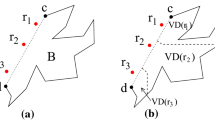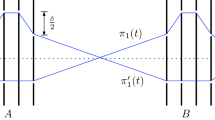Abstract
We introduce a new algorithm for computing Euclidean shortest paths in the plane in the presence of polygonal obstacles. In particular, for a given start points, we build a planar subdivision (ashortest path map) that supports efficient queries for shortest paths froms to any destination pointt. The worst-case time complexity of our algorithm isO(kn log2 n), wheren is the number of vertices describing the polygonal obstacles, andk is a parameter we call the “illumination depth” of the obstacle space. Our algorithm usesO(n) space, avoiding the possibly quadratic space complexity of methods that rely on visibility graphs. The quantityk is frequently significantly smaller thann, especially in some of the cases in which the visibility graph has quadratic size. In particular,k is bounded above by the number of different obstacles that touch any shortest path froms.
Similar content being viewed by others
References
H. Alt and E. Welzl, Visibility graphs and obstacle-avoiding shortest paths, Z. Oper. Res. 32 (1989) 145–164.
B. Aronov, On the geodesic Voronoi diagram of point sites in a simple polygon, Algorithmica 4 (1989) 109–140.
T. Asano, T. Asano, L.J. Guibas, J. Hershberger and H. Imai, Visibility of disjoint polygons, Algorithmica 1 (1986) 49–63.
J. Canny and J. Reif, New lower bound techniques for robot motion planning problems,Proc. 28th FOCS (Oct. 1987) pp. 49–60.
K. Clarkson, Approximation algorithms for shortest path motion planning,Proc. 19th Annual ACM Symp. on Theory of Computing, New York City (May 25–27, 1987) pp. 56–65.
K. Clarkson, S. Kapoor and P. Vaidya, Rectilinear shortest paths through polygonal obstacles inO(n log2 n) time,Proc. 3rd Annual ACM Conf. on Computational Geometry, Waterloo, Ontario (1987) pp. 251–257 (to appear in Algorithmica).
Dijkstra, A note on two problems in connection with graphs, Num. Mathematik 1 (1959) 269–271.
H. Edelsbrunner, L.J. Guibas and J. Stolfi, Optimal point location in a monotone subdivision, SIAM J. Comput. 15 (1986) 317–340.
S.K. Ghosh and D.M. Mount, An output sensitive algorithm for computing visibility graphs,Proc. 28th Annual IEEE Symp. on Foundations of Computer Science (1987) pp. 11–19.
L.J. Guibas, J. Hershberger, D. Leven, M. Sharir and R. Tarjan, Linear time algorithms for visibility and shortest path problems inside triangulated simple polygons, Algorithmica 2 (1987) 209–233.
L.J. Guibas, M. Sharir and S. Sifrony, On the general motion planning problem with two degrees of freedom, Discr. Comput. Geom. 4 (1989) 491–521.
L.J. Guibas and J. Stolfi, Primitives for the manipulation of general subdivisions and the computation of Voronoi diagrams, ACM Trans. Graphics 4 (1985) 74–123.
S. Kapoor and S.N. Maheshwari, Efficient algorithms for Euclidean shortest path and visibility problems with polygonal obstacles,Proc. 4th Annual ACM Symp. on Computational Geometry, Urbana-Champaign, IL (June 6–8, 1988) pp. 172–182.
D.T. Lee, Proximity and reachability in the plane, Ph.D. Thesis, Technical Report ACT-12, Coordinated Science Laboratory, University of Illinois (Nov. 1978).
D.T. Lee and F.P. Preparata, Euclidean shortest paths in the presence of rectilinear boundaries, Networks 14 (1984) 393–410.
J.S.B. Mitchell, Planning shortest paths, PhD Thesis, Department of Operations Research, Stanford University (August, 1986).
J.S.B. Mitchell, Shortest rectilinear paths among obstacles, Technical Report No. 739, School of Operations Research and Industrial Engineering, Cornell University (April, 1987) (revised version to appear in Algorithmica).
J.S.B. Mitchell, A new algorithm for shortest paths among obstacles in the plane, Technical Report No. 832, School of Operations Research and Industrial Engineering, Cornell University (October, 1988).
J.S.B. Mitchell, An algorithmic approach to some problems in terrain navigation, Art. Intell. 37 (1988) 171–201.
J.S.B. Mitchell, D.M. Mount and C.H. Papadimitriou, The discrete geodesic problem, SIAM J. Comput. 16 (4) (1987) 647–668.
N.J. Nilson,Principles of Artificial Intelligence (Tioga Publ. Co., Palo Alto, CA, 1980).
M.H. Overmars and E. Welzl, New methods for computing visibility graphs,Proc. 4th Annual ACM Symp. on Computational Geometry, Urbana-Champaign, IL (June 6–8, 1988) pp. 164–171.
J.H. Reif and J.A. Storer, Shortest paths in Euclidean space with polyhedral obstacles, Technical Report CS-85-121, Computer Science Department, Brandeis University (April, 1985).
H. Rohnert, Time and space efficient algorithms for shortest paths between convex polygons, IPL 27 (1988) 175–179.
M. Sharir and A. Schorr, On shortest paths in polyhedral spaces, SIAM J. Comput. 15 (1) (1986) 193–215.
E. Welzl, Constructing the visibility graph forn line segments inO(n 2) time, Inf. Processing Lett. 20 (1985) 167–171.
C.K. Yap, Algorithmic motion planning, in:Advances in Robotics: Vol. 1, eds. J.T. Schwartz and C.K. Yap (Lawrence Erlbaum Assoc., 1987) pp. 95–143.
G.E. Wangdahl, S.M. Pollock and J.B. Woodward, Minimum-trajectory pipe routing, J. Ship Res. 18 (1974) 46–49.
Author information
Authors and Affiliations
Additional information
Partially supported by NSF Grants IRI-8710858 and ECSE-8857642 and by a grant from Hughes Research Laboratories, Malibu, CA.
Rights and permissions
About this article
Cite this article
Mitchell, J.S.B. A new algorithm for shortest paths among obstacles in the plane. Ann Math Artif Intell 3, 83–105 (1991). https://doi.org/10.1007/BF01530888
Issue Date:
DOI: https://doi.org/10.1007/BF01530888




